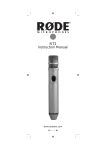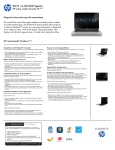Download Rode NT3 Professional Microphone
Transcript
NT 3 Instruction Guide RØDE STUDIO CONDENSER MICROPHONES RØDE NT 3 Serial Number: … … … … … … … … Checked by: … … … … … … … … … Date: … … … … … … … … … … … … This condenser microphone has been proudly designed and manufactured by RØDE Microphones in Sydney, Australia. We at RØDE thank you for investing in our product and with the appropriate care, it will serve you well for many years to come. Please take the time to read the following information which will help you to achieve the best possible performance from your NT3. Peter Freedman RØDE Microphones SPECIFICATIONS: • Capsule: • Active Electronics: • Polar Pattern: • Frequency Response: Externally polarised 19mm (3/4”) condenser J-FET impedance converter with bipolar output buffer Hypercardioid (see graph) 20 Hz –20 kHz (see graph) • Output Impedance: 200 ohm • Sensitivity: -39dB re 1 volt/pascal (12mV @ 94dB SPL) +/- 2dB • Equivalent Noise: <16dB SPL (“A”weighted per IEC268-15) • Maximum Output: +9.5dBu (@ 1% THD into 1K ohm • Dynamic Range: >123dB (per IEC268-15) • Maximum SPL: >140dB SPL (@1% THD into 1K ohm • Signal/Noise Ratio: >77dB (per IEC268-15) • Power Requirements: 8mA @ P48 (20-60v) 7mA @ P24 (12-30v) 1.4mA @ P12 (11026v) 1.2mA @9v (Battery) • Dimensions (Microphone only) 270mm x 130mm x 50mm • Weight (Microphone without battery): 371g • Packed Weight: 640 • Packed Dimensions: 270mm x 130mm x 50mm FEATURES: • • • • • • • • • • • Transformerless output Internal capsule shock-mounting Heavy-duty cast metal satin nickel body High immunity to RF interference High-strength welded and heat-treated mesh head Premium quality surface-mount components True condenser (externally biased) Hypercardioid polar response Full frequency response Battery status indicator 12 months parts and labour guarantee Accessories: • ZP1. Zip Pouch • WS3. Wind Shield • RM3. Stand Mount (with 3/8”-5/8”thread adaptor) THE NT3 is suitable for a wide range of applications. Recording, stage, and location work are all well within the capabilities of this hypercardioid condenser microphone. Its low noise and full frequency response ensure the sound quality expected by todays musicians and engineers. 1. You may use either phantom power (see Specifications) or 9V battery to operate your NT3. 2. Most professional mixing consoles include a 48 volt phantom power supply; if yours does not, a separate one may of course be used. Ensure that whichever power supply you use, it is a professional unit and is working correctly. 3. If you choose to use battery power, a 9 Volt (PP3) battery should be fitted into the cavity within the microphone body ensuring correct polarity (+ to + and - to -). We recommend that you use a high quality alkaline battery. To fit the battery, simply unscrew the lower section of the body and insert the battery into the cavity (terminals first). Secure the battery in place with the flexible spring clip and reassemble the body, screwing the sections firmly together. 4. The ON/OFF switch turns the microphone ON or OFF when powered by either phantom or battery. When using battery power, the switch should be switched to OFF when the microphone is not in use. If left ON, the battery power will be unnecessarily depleted. We recommend that during long periods of non-use, the battery should be removed, as it may leak, and that could damage your NT3. When the NT3 is switched ON, the red battery status L.E.D. (light-emitting-diode) gives an indication of battery power and should always be carefully observed. When the L.E.D. flashes (illuminates for about 1 second), the battery power is ‘good’. If the L.E.D. remains illuminated significantly longer, the battery should be replaced. Tests have shown a life expectancy for a high quality alkaline battery used in the NT3 to be in excess of 400 hours.* *NOTE: This is equal to 8 hours recording per week for a year (including 2 weeks holidays!!!) 5. The NT3 may be connected direct to a mixer (recording or live) and battery power will only be required if the mixer does not have an inbuilt phantom P48 supply. Connection may also be made direct to a portable DAT or other tape machine enabling field/location operation using the 9V battery supply. 6. A stand mount clip (RM-3) is included with your NT3, and should be used to connect the NT3 firmly and safely to a stable microphone stand. 7. Always use a good quality microphone cable and ensure that it is wired Pin1 Screen, Pin 2+, Pin 3-. You may of course use XLR-XLR, XLR-jack, or XLR-mini jack plugs depending on your relevant input socket. We recommend that all connections made to the mixer or recorder are made with the attenuation (gain) set to OFF. 8. When first switching the mixer ON and phantom power is applied to the NT3, or when the microphone battery power is switched ON, several seconds should be allowed for the microphone to stabilize. Note: When using phantom power, a battery may be in or out; it is ineffective in that situation. 9. To ensure the lowest noise/distortion, your mixer input gain control should be set so that the Peak Program Indicator (P.P.I.) L.E.D. flashes ON during peaks (high levels) of the program source (Voice/Instrument). If there is no P.P.I., adjust the input gain while listening for distortion of the sound. As distortion is heard, reduce the gain gradually until the sound is undistorted (clean). 10. Sound quality is of course subjective and ‘your sound’ will be achieved by you with experimentation. We suggest that you begin with EQ set FLAT/OFF (no boost or cut). Remember the EQ cannot change the acoustic properties of a room. In a recording situation, you should try placing absorbent or reflective panels/material in various positions within the vicinity of the sound source and microphone. The positioning of the microphone can also have a dramatic effect on the sound quality. The best way to assess your recording environment, is to listen to the sound you wish to record acoustically first. Remember that no amount of EQ can correct a ‘bad’ recording environment. Any further desired modification of sound can then be undertaken with the EQ and effects. 11. Live/Stage Use. As a live vocal mic, the NT3 offers studio-quality sound on stage, which is not achievable with a dynamic microphone. A characteristic of most dynamic vocal microphones is that their ‘full frequency response’ is only evident when they are used very close to the sound source (within the proximity effect area). The low frequency of the NT3 extends to below 20Hz which is an attractive quality for most recording situations. For live performance however, you may wish to reduce these frequencies when using the NT3 as a vocal microphone. If you have a high pass filter/bass roll-off, switch it in. Alternatively, try moving the microphone away from the sound source (out of the proximity effect). This basic microphone control/technique should be practiced, to ensure that the best possible results are achieved. 12. Like all condenser microphones, the NT3 should be kept dry at all times. These microphones do not like moisture! The capsule will be potentially subject to moisture during vocal use, and we strongly recommend the use of the WS3 foam windscreen (supplied with your NT3) during all vocal applications. This screen will also minimise plosives (the high sound pressure levels of pronounced B’s and P’s which can bottom-out the capsule. 13. The NT3 is a precision transducer and you should be careful not to drop or knock it as this could cause serious damage. After use, the NT3 should be wiped clean with a soft cloth, and stored in its protective zip pouch together with the pack of moisture absorbent crystals (silica gel/dessicant). These crystals should be blue. If they have turned to pink they are no longer active. To reactivate them, place the pack in an oven set between 100-150 degrees C until they become blue again. Note: There are no user serviceable parts inside this microphone so there will never be reason for you to dismantle it (except to replace the battery). Any service which may require dismantling must be performed by an authorised RØDE Service Agent. Warranty Service: All RØDE products are warranted for one year from date of purchase and the warranty card should be used to register that purchase. The warranty covers parts and labour that may be required to repair the microphone during the warranty period. The warranty excludes defects caused by normal wear and tear, modification, shipping damage, or failure to use the microphone as per the instruction guide. If you experience any problem, or have any questions regarding your RØDE microphone, first contact the Dealer who sold it to you, If the microphone requires Factory authorised service, return will be organised by that Dealer. We have an extensive Distributor/Dealer network, but if you have difficulty getting the advice or assistance you require, do not hesitate to contact us directly. International: Tel: 61 -2 8765 9333 Fax: 61 -2 8765 9444 Australia: Tel: (02) 8765 9333 Fax: (02) 8765 9444 USA: Tel: 310-328-7456 Fax: 310-328-7180 e-mail information: [email protected] www.rodemicrophones.com or contact your local RØDE Distributor













![[ENG] – User Manual](http://vs1.manualzilla.com/store/data/005937687_1-f702f1a8e36ebc72a0042f3feab98ee4-150x150.png)

